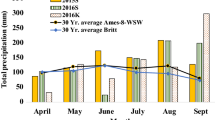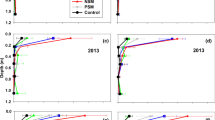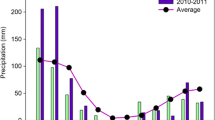Abstract
Cereal grain cover crops increase surface cover, anchor corn (Zea mays L.) and soybean [Glycine max (L.) Merr.] residues, increase infiltration, reduce both rill and interrill erosion, scavenge excess nutrients from the soil, and are easily obtained and inexpensive compared to other cover crop options. The use of cereal grain cover crops in fields where manure application occurs should increase nitrogen (N) recovery and cycling for use in subsequent crops. The objectives of this study were to determine if a rye (Secale cereale L.) cover crop increases N retention after soil application of swine lagoon slurry. Experiments were conducted in a controlled environment chamber using plastic buckets as the experimental units. Three manure-N loading rates (no manure, low, high) were applied to soils with and without a rye cover crop. A partial N balance was determined from measurements of NO3 leaching, N2O and NH3 emissions, cover crop N uptake, and NO3 + NH4 remaining in the soil. Cumulative nitrate load in the drainage water was less than 0.31 g m−2 NO3-N for rye treatments regardless of the manure rate, however in the fallow treatments, at the high manure rate NO3 leaching losses were 6.28 and 3.77 g m−2 NO3-N, for experiments 1 and 2, respectively. Rye N uptake ranged from 2.95 g N m−2 to 10.7 g N m−2, and was related to manure rate. Rye had lower cumulative N2O emission than the no rye treatment for the high manure treatment. Ammonia emissions were low for all treatments during both experiments, which was probably related to the rapid manure incorporation after application. Rye can increase N retention, reduce cumulative N2O emissions, and reduce cumulative N load in drainage water when manure is applied to soils. Nitrogen balance calculations in the cover crop treatments accounted for less than the equivalent of 50% of the added manure N. We speculate that the living rye plants may have increased immobilization of N in the organic N pools.
Similar content being viewed by others
Notes
Mention of trade names or proprietary products does not indicate endorsement by USDA and does not imply its approval to the exclusion of other products that may be suitable.
References
Andrews WF, Diderikson RO (1981) Soil survey of Boone County, Iowa, USDA-SCS US Gov. Printing Office, Washington, DC
Bakhsh A, Kanwar RS, Karlen DL (2005) Effects of liquid swine manure applications on NO3-N leaching losses to subsurface drainage water from loamy soils in Iowa. Ag Ecosyst Environ 109:118–128
Bremer E, Kuikman P (1997) Influence of competition for nitrogen in soil on net mineralization of nitrogen. Plant Soil 190:119–126
Clarholm M (1985) Interactions of bacteria, protozoa and plants leading to the mineralization of soil nitrogen. Soil Biol Biochem 17:181–187
Dinnes DL, Karlen DL, Jaynes DB, Kaspar TC, Hatfield JL, Colvin TS, Cambardella CA (2002) Nitrogen management strategies to reduce nitrate leaching in tile-drained Midwestern soils. Agron J 94:153–171
Dormaar JF (1990) Effect of active roots on the decomposition of soil organic materials. Biol Fertil Soils 10:121–126
Griffiths B, Robinson D (1992) Root-induced nitrogen mineralization: a nitrogen balance model. Plant Soil 139:253–263
Haider K, Mosier A, Heinemeyer O (1985) Phytoron experiments to evaluate the effect of growing plants on denitrification. Soil Sci Soc Am J 49:636–641
Haider K, Mosier A, Heinemeyer O (1987) The effect of growing plants on denitrification at high soil nitrate concentrations. Soil Sci Soc Am J 51:97–102
Ingham RE, Trofymow JA, Engham ER, Coleman DC (1985) Interactions of bacteria, fungi, and their nematode grazers: effects on nutrient cycling and plant growth. Ecol Monogr 55:119-140
Keeney DR, Nelson DW (1982) Nitrogen-inorganic forms. In: Page AL et al. (eds) Methods of soil analysis, Part 2, 2nd edn. Agron. Monogr. 9. Am Soc Agron., Madison, WI, pp 643–698
Kempers AJ, Zweers A (1986) Ammonium determination in soil extracts by the salicylate method. Commun Soil Sci Plant Anal 17:715–723
Kissel DE, Brewer HL, Arkin GF (1977) Design and test of a field sampler for ammonia volatilization. Soil Sci Soc Am J 41:1133–1138
Logsdon SD, Kaspar TC, Meek DW, Prueger JH (2002) Nitrate leaching as influenced by cover crops in large soil monoliths. Agron J 94:807–814
Meisinger JJ, Hargrove WL, Mikkelsen RL, Williams JR, Benson VW (1991) Effects of cover crops on groundwater quality. In: Hargrove WL (ed) Cover crops for clean water. Proc. of an international conf. April 9–11, 1991. Jackson TN. Soil and Water Conservation Society, Ankeny, IA, pp 57–68
Schepers JS, Francis DD, Thompson MT (1989) Simultaneous determination of total C, total N, and 15N on soil and plant material. Commun Soil Sci Plant Anal 20:949–959
Sharpley A, Meisinger JJ, Breeuwsma A, Sims JT, Daniel TC, Schepers JS (1998) Impacts of animal manure management on ground and surface water quality. In: Hatfield JL, Stewart BA (eds) Animal waste utilization: effective use of manure as a soil resource. Ann Arbor Press, Chelsea, MI, pp 173–242
Smith MS, Tiedje JM (1979) The effect of roots on soil denitrification. Soil Sci Soc Am J 43:951–955
Smucker AJM, McBurney SL, Srivastava AK (1982) Quantitative separation of roots from compacted soil profiles by the hydropneumatic elutriation system. Agron J 74:500–503
Sogaard HT, Sommer SG, Hutchings NJ, Hijsmans JFM, Bussink DW, Nicholson F (2002) Ammonia volatilization from field-applied animal slurry—the ALFAM model. Atmos Environ 36:3309–3319
Sommer SG, Hutchings NJ (2001) Ammonia emission from applied manure and its reduction—invited paper. Europ J Agron 15:1–15
Thompson RB, Meisinger JJ (2002) Management factors affecting ammonia volatilization from land-applied slurry in the Mid-Atlantic USA. J Environ Qual 31:1329–1338
Thompson RB, Meisinger JJ (2004) Gaseous nitrogen losses and ammonia volatilization measurement following land application of cattle slurry in the mid-Atlantic region of the USA. Plant Soil 266:231–246
Acknowledgements
The authors wish to thank Otis Smith, Ben Knutson, Jim Seevers, and Keith Kohler for technical assistance, and Brian Kerr for supplying the liquid swine manure. Partial funding for this work was provided by the Iowa Pork Producers Association.
Author information
Authors and Affiliations
Corresponding author
Rights and permissions
About this article
Cite this article
Parkin, T.B., Kaspar, T.C. & Singer, J.W. Cover crop effects on the fate of N following soil application of swine manure. Plant Soil 289, 141–152 (2006). https://doi.org/10.1007/s11104-006-9114-3
Received:
Accepted:
Published:
Issue Date:
DOI: https://doi.org/10.1007/s11104-006-9114-3




